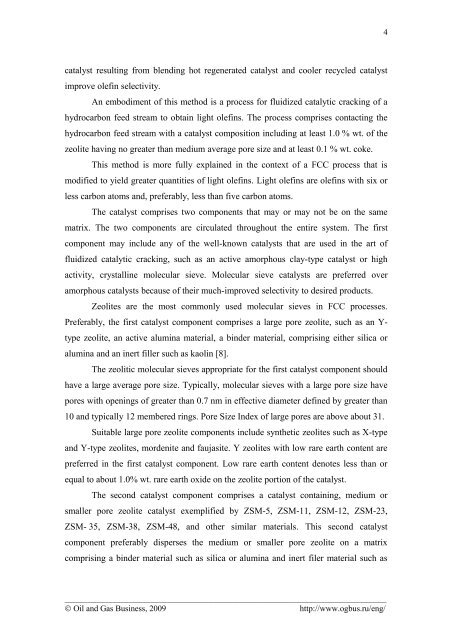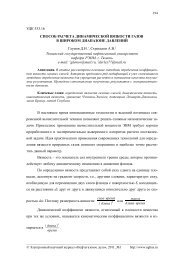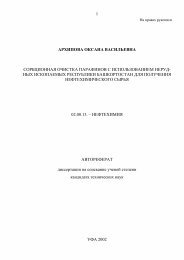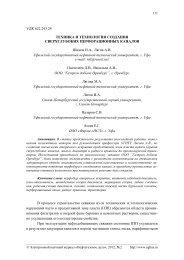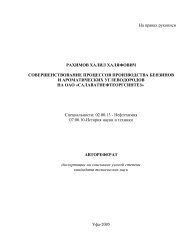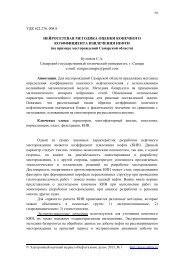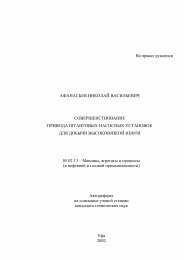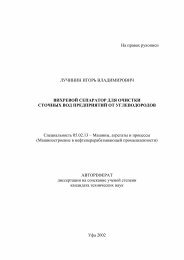FCC PROCESS OF HEAVY FEED STOCK WITH IMPROVED YIELD ...
FCC PROCESS OF HEAVY FEED STOCK WITH IMPROVED YIELD ...
FCC PROCESS OF HEAVY FEED STOCK WITH IMPROVED YIELD ...
You also want an ePaper? Increase the reach of your titles
YUMPU automatically turns print PDFs into web optimized ePapers that Google loves.
catalyst resulting from blending hot regenerated catalyst and cooler recycled catalyst<br />
improve olefin selectivity.<br />
An embodiment of this method is a process for fluidized catalytic cracking of a<br />
hydrocarbon feed stream to obtain light olefins. The process comprises contacting the<br />
hydrocarbon feed stream with a catalyst composition including at least 1.0 % wt. of the<br />
zeolite having no greater than medium average pore size and at least 0.1 % wt. coke.<br />
This method is more fully explained in the context of a <strong>FCC</strong> process that is<br />
modified to yield greater quantities of light olefins. Light olefins are olefins with six or<br />
less carbon atoms and, preferably, less than five carbon atoms.<br />
The catalyst comprises two components that may or may not be on the same<br />
matrix. The two components are circulated throughout the entire system. The first<br />
component may include any of the well-known catalysts that are used in the art of<br />
fluidized catalytic cracking, such as an active amorphous clay-type catalyst or high<br />
activity, crystalline molecular sieve. Molecular sieve catalysts are preferred over<br />
amorphous catalysts because of their much-improved selectivity to desired products.<br />
Zeolites are the most commonly used molecular sieves in <strong>FCC</strong> processes.<br />
Preferably, the first catalyst component comprises a large pore zeolite, such as an Y-<br />
type zeolite, an active alumina material, a binder material, comprising either silica or<br />
alumina and an inert filler such as kaolin [8].<br />
The zeolitic molecular sieves appropriate for the first catalyst component should<br />
have a large average pore size. Typically, molecular sieves with a large pore size have<br />
pores with openings of greater than 0.7 nm in effective diameter defined by greater than<br />
10 and typically 12 membered rings. Pore Size Index of large pores are above about 31.<br />
Suitable large pore zeolite components include synthetic zeolites such as X-type<br />
and Y-type zeolites, mordenite and faujasite. Y zeolites with low rare earth content are<br />
preferred in the first catalyst component. Low rare earth content denotes less than or<br />
equal to about 1.0% wt. rare earth oxide on the zeolite portion of the catalyst.<br />
The second catalyst component comprises a catalyst containing, medium or<br />
smaller pore zeolite catalyst exemplified by ZSM-5, ZSM-11, ZSM-12, ZSM-23,<br />
ZSM- 35, ZSM-38, ZSM-48, and other similar materials. This second catalyst<br />
component preferably disperses the medium or smaller pore zeolite on a matrix<br />
comprising a binder material such as silica or alumina and inert filer material such as<br />
_____________________________________________________________________________<br />
© Oil and Gas Business, 2009 http://www.ogbus.ru/eng/<br />
4


